High Schoolers Gain Authentic Research Experience at Illinois
July 9, 2012

Dr. Junhua Jiang, Illinois Sustainable Technology Center Senior Research Engineer, with Central High School senior Chris Yim
For some students, participating in this summer's I-STEM High School Summer Research Experience confirmed their inclination to pursue a career in a specific STEM field. For others, STEM is now a viable career option. For others still, it convinced them that the field in which they conducted research is the last field they would ever consider for a career. Every student came out with a better understanding of STEM. Just as intended.
A total of 25 students from University Laboratory High School and Central High School participated in the second I-STEM High School Summer Research Experience. Performing research ranging from psychological to meteorological, students spent four weeks with assigned Illinois professors and presented posters on their research during the final week.
“High school students bring incredible energy and a can-do spirit,” Bioengineering professor Rohit Bhargava said. “They change the dynamic of the group.”
I-STEM Education Initiative director, Lizanne DeStefano, said the program aims to provide students with authentic research experience. “It is just as important for these young minds to learn what it is to be on a research team,” DeStefano said. “That way both the students and the University are exposed to new ideas.”
One student landed a paid position in his summer lab. Henry Carlton, a rising senior at Uni High, so impressed Agricultural and Biological Engineering professor Alan Hansen that Carlton earned an extended summer stay.
“This program enabled high school students to receive an early experience with scientific research,” Professor Andrew Miller said. “Both my lab and the students gained from this experience.”
Uni High Teaching Associate David Stone said the feedback from this year’s program has been very positive. “This program has created a number of long-term relationships between students and professors as well as high school teachers and University professors,” Stone said. “This opportunity provided students with a better sense of what they want during their undergraduate institution selection process.”
For some students, this summer confirmed their inclination to pursue a career in a specific STEM field. For others, STEM is now a viable career option. For others still, it convinced them that the field in which they conducted research is the last field they would ever consider for a career. Every student came out with a better understanding of STEM. Just as intended.
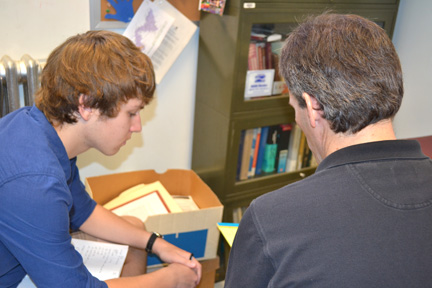
David Bergveldt meets with an Illinois researcher to discuss his project.
Working with Dr. Don Keefer and Dr. Ed Mehnert, David Bergvelt analyzed geological data from the Midwest. In an effort to fight global warming, Dr. Mehnert of the Illinois State Geological Survey is exploring the potential of geologic carbon sequestration—the placement of carbon dioxide below earth’s subsurface. Using mapping software such as ArcMap and GSI3D in the Visualization Lab, Bergvelt helped Dr. Keefer determine the hydraulic conductivity and transmissivity of glacial deposits. Ever since watching Bill Nye The Science Guy in elementary school, Bergvelt has been drawn to STEM and plans to pursue a degree in either science or engineering in college. Bergvelt hoped to get an experience that he would not normally get in the classroom, and he found just that. “The I-STEM program has more than met my expectations,” Bergvelt said.

Dr. Rashid Bashir with his two-time summer student Chelsea Edwards. Edwards and Dr. Bashir picked up where they left off last summer on their work toward developing a chip that can test for malaria and AIDS.
For her second consecutive summer, Chelsea Edwards worked with Dr. Rashid Bashir, Director of the Micro and Nanotechnology Laboratory. Building on last year’s work, Edwards continued to develop a chip that can count malarial parasites and CD4+ T-cells in blood. The chip could become a cheap and quick way to test for malaria and AIDS. “The chip I designed last year was very theoretical. This year I worked toward actually building it and testing it.” Edwards was happy to spend more time in the lab than last year and compared the building process to constructing a mechanical pencil from scratch, including all the plastic. Edwards knows she wants to enter a STEM field and the past two summers have attracted her toward health applications. “I never thought I would want to be a doctor, but research like this can help so many people.” The ambitious goal of Rashid Bashir's Lab-on-a-Chip project is to create the technology to do cell counts for all blood maladies.
Nathan Beauchamp’s first lesson was one of patience. “I expected that we would be able to get right into the lab work and start testing. However, I spent the first two weeks doing preparatory work, obtaining materials and troubleshooting technology problems.” Once in the Unit Operations Lab in the basement of Roger Adams Laboratory, Beauchamp reveled in the possibilities of his 3-D printing research. The 15-year-old researched the effects of dyes used in 3-D printing on the growth of yeast and E. coli cell growth. The dyes currently used in 3-D printing are carcinogenic; but if benign dyes can be found, 3-D printing could potentially be used to build biological materials or machines. Working with Dr. Jerrod Henderson of Chemical and Bimolecular Engineering, Beauchamp is now considering going into a field that combines science with engineering—such as Chemical Engineering or Bioengineering. Fascinated with STEM and its potential to help the world, Beauchamp eagerly anticipates the results of his research.
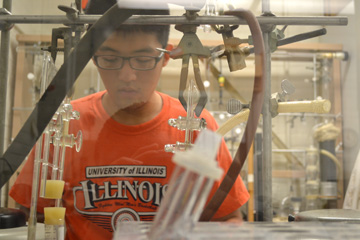
David Gong analyzes bone samples in Dr. Kristin Hedman's lab.
The American Bottom, home of the Cahokia Mounds Site located near St. Louis, provided the materials for David Gong’s studies. Working with Dr. Kristin Hedman of the Illinois State Archaeological Survey, Gong prepared bone and enamel samples from skeletal remains for stable isotope analysis. The analysis can reveal the diet of the ancient bone owner. Archaeologists can use dietary information to better understand ancient cultures. Gong examined a skeleton and learned how to identify age, sex, and possible trauma experienced. Gong believes he will enter a STEM field, just not archaeology. “I have a very short attention span, so having to come into a lab every day to crush some bones and runs some tests would wear on me.” Part of learning what is right for you is learning what is not.
Professor Placid Ferreira, department head of Mechanical Science and Engineering introduced Leif Hague to his study on the photoconductivity of silicone. Photoconductivity is the property of increased conductivity when exposed to light. With nanoscale printing techniques in mind, Hague spent the first three weeks of his experience conducting background research and theoretical preparation. Hague’s experiment took five hours to complete and explored the photoconductivity of two different silicone samples. While the results were inconclusive and “the theoretical stuff on paper can get old,” it was all worth it in the end. “It was cool to see the design that I set up in the clean room,” Hague said. Hague knows that he wants to be in a STEM field and has been interested in nanotechnology for a while. “I have always wanted to be involved with science, but this summer showed me new possibilities that I had not previously considered.”

Uni High senior Sarah Keeley separates insects under the guidance of Professor May Berenbaum.
How does the expansion of biofuels affect population diversity in bugs? Sarah Keeley worked with Dr. Terry Harrison to find out. Keeley was pleased to learn about lab procedure and “learned a lot about processing samples and categorizing them.” While Keeley may not want to pursue a career in entomology, she did learn that she could have a fun time in a lab, which reinforced her existing desire to enter a STEM field. A lover of the life sciences, she plans to study medicine or a similar field in college when she enters in 2014.
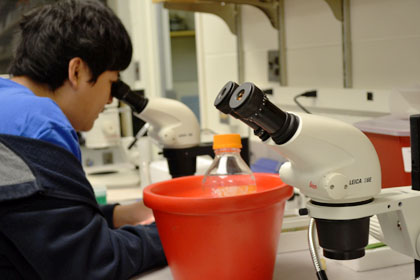
Uni High junior Shawn Lu peers through the microscope.
Xun Lu explored the effect of RNA mutation on localization in the nucleus with Dr. Michel Bellini in Morrill Hall. The goal was to understand exactly what each mutation type does to the RNA. The Uni High rising junior wants a career in chemistry or physics in the future and participates in every math and science activity he can. He credits this summer in the lab for improving his lab performance.
George Ruan explored the genetic sequences in fly embryos that can be turned on and off. Ruan’s project examined different scientific articles to find mutant embryos that result from certain genetic sequences being removed, which prevents the sequence from turning on. Working under Dr. Saurabh Sinha, Ruan expected his experience to be a bit more hands-on, but did not mind the other side of lab work. The rising senior at Uni High hopes to go into the medical field and credits his summer experience with opening his eyes to the research side of medicine.
Sitting in front of a pair of computer screens, Patrick Wong used Visual Molecular Dynamics to make a demonstration for Photosystem II. Under the guidance of Postdoctoral Research Associate Sharlene Danos, Wong says his summer experience showed him that programming and visualization programs can be interesting and fun. The Uni High rising senior says he will likely enter a STEM field but is interested in electrical engineering, medical research and business as well.

Uni High's Sherry Qiu working in Illinois lab.
“This experience far exceeded my expectations in terms of being able to conduct experiments,” Sherry Qiu said. Working with Dr. Aditi Das in the Department of Comparative Biosciences at the Vet Med Basic Building, Qiu’s project sought to express and purify tobacco etch virus (TEV) protease, which is used to cleave protein with the TEC site. Hoping to glean a deeper understanding of research, Qiu’s experience “far exceeded (her) expectations in terms of being able to conduct experiments.” The rising senior enjoys her math and science classes at Uni High School and delighted in growing and studying live cells this summer. She hopes to incorporate biology in the STEM career she plans to pursue.
Working with with Paul Tenczar, Petra Rantanen tagged bees using radio frequency identification (RFID) tags. The goal of the project was to record the comings and goings of the hive’s bees. Rantanen learned what life as a researcher can be like, and while she found it fascinating, she hopes to practice a career with a broader focus. The Uni High rising senior aspires to become a medical doctor.
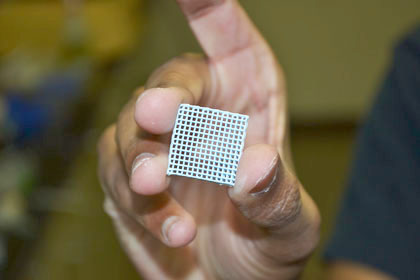
Uni High senior Sunjay Koshy holds a hyrdoxyapatite bone scaffolding. The material can be surgically impanted to support fractured or weak bones.
“After doing this for two summers, I definitely want to have a career in a STEM field,” Sunjay Kosky said. After studying the connections between exercise and memory last summer, Koshy experimented with hydroxyapatite this summer under the guidance of Professor Amy Wagoner Johnson. The calcium phosphate material is used in bone scaffolding, which is a surgical procedure in which support is provided to fractured or degenerative bones. The experimentation altered the surface energy of hydroxyapatite in an effort to improve the material as a scaffold. Koshy would place a droplet of water on a plate of hydroxyapatite and measure the contact angle on a goniometer. A smaller contact angle meant a great surface energy. Always interested in a career in medicine or bioengineering, Koshy found that this summer reaffirmed his goals. “This summer’s internship has been a great experience for me, exceeding all expectations I had.”
Thomas E. Workoff, David A. R. Kristovich, Neil F. Laird, Robert LaPlante and Daniel Leins needed someone to corroborate their findings in Influence of the Lake Erie Over-Lake Boundary Layer on Deep Convective Storm Evolution. Vinay Shanbhag was their man. The findings explored the increase and decrease of different storm types as they moved from land to Lake Erie. Shanbhag did similar research with storms moving from land to the ocean. “I knew that in order to research storms, I wouldn’t be standing a couple miles from them, but in an office with all the data available.” Shanbhag was happy to pick up research experience and understanding of the STEM fields he plans to make a career in one day.
Kedar Vaidya worked under Prof. Alexander Vakakis to measure how objects vibrate. Vaidya would measure the amplitude of different points on a beam with a scanning laser vibrometer after the beam was struck with a modally tuned hammer. While Vaidya does not see a career in experimentation for himself, he does want to pursue a STEM career. The Uni High rising junior credits his summer experience with opening his eyes to mechanical engineering. He prefers computer engineering.
Not every student spent time in a lab wearing a white coat. Freddie Stavins studied the function of gesture and how it correlates with verbal working memory. Under the guidance of Professor Duane Watson, Stavins’ work involved video splicing, coding and running participants through a series of verbal working memory tasks. “While I do not see myself doing something in the field of psychology, I’ve definitely found it interesting how people possess a wide range of verbal skill sets and intellectual abilities.” Stavins’ summer experience reaffirmed his interest in STEM. He would like to become a medical researcher as well as a practicing doctor.
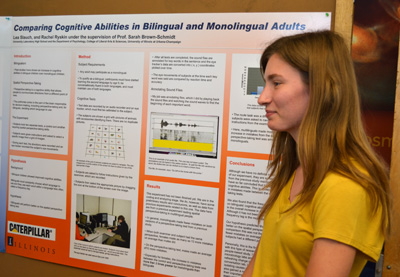
Lea Slauch discusses her project with interested attendees during the poster presentation.
Does being bilingual make you a quicker thinker? Lea Slauch compared the cognitive abilities of monolingual people to bilingual people to find out. Working under Prof. Sarah Brown-Schmidt, Slauch specifically assisted graduate student Rachel Ryskin. The experiment required an examiner to instruct the participant to shift his or her eyes to different images on a computer screen. An eye tracker measured how quickly the participant located the specified item. In the original test, both the participant and the examiner looked at similar screen images. In the second test, the map would be flipped for the examiner, and the participant would have to compensate for the inversed instructions. While monolingual people outperformed bilingual people in the original test, bilingual people experienced only a slight slowdown in the second test, while monolingual participants experienced a more pronounced drop in performance. The Uni High rising junior credits the summer experience with expanding her perception of research.
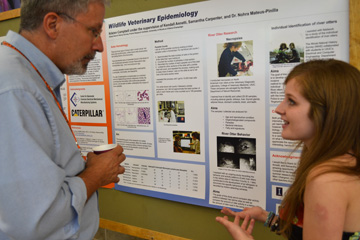
Kristin Campbell discuss her river otter project with I-STEM Associate Director Bob Coverdill during the poster session.
Kristen Campbell took a summer trip into the world of veterinary epidemiology. Campbell worked on avian hematozoa identification as well as a river otter project. With Dr. Nohra Mateus-Pinilla, Campbell conducted river otter necropsies. The Central High School student had zero previous experience in field biology. “I have really been enjoying my experience, and it has definitely influenced my thoughts on potential careers. I wasn’t really considering veterinary school before this, but now I am actually really interested in pursuing (veterinary school) or a career in wildlife research.”
Working with Dr. Junhua Jiang, the Senior Research Engineer of the Illinois Sustainable Technology Center, Chris Yim used biochar—an abundant form of charcoal—to build cost-effective electrodes for the detection of nitrite in water. In his second week of research, Yim built homemade electrodes. While he had no previous training with electroanalytical chemistry, Yim now says he could see himself conducting research similar to what he did this summer in his career. “This experience has given me insight into what true research is. It also solidified my interest in the engineering field; I would rather work with computers than chemicals.” Yim also learned that research takes patience and hard work. In his first week his apparatus was contaminated and his electrodes had high resistivity.
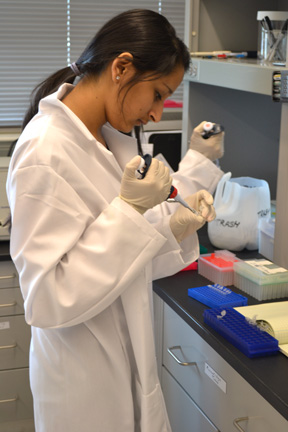
Shivali Patel conducting research in Illinois lab..
White-Nose Syndrome is associated with the death of approximately six million North American bats. Shivali Patel worked with Dr. Andrew N. Miller to decode the DNA of cave fungi in an effort to discover which species of fungi causes the syndrome. “This experience has been very valuable because I am getting the chance to analyze data and explore species that I have never seen before.” A highlight for Patel has been learning polymerase chain reaction technique, which magnifies DNA pieces across several orders of magnitude, thus creating thousands to millions of copies of the DNA sequence. The Central High School student credits her time in the lab this summer for her emerging consideration of a career in a STEM field.
Author/Photographer: Phil Johnson, Communications Intern, I-STEM Education Initiative
More: 8-12 Outreach, High School Research, I-STEM Initiatives, Summer Research, 2012













.jpg)
















